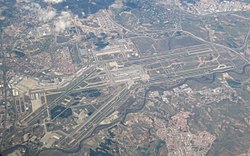Adolfo Suárez Madrid–Barajas Airport
|
Adolfo Suárez Madrid–Barajas Airport Aeropuerto Adolfo Suárez Madrid-Barajas |
|||||||||||||||||||||||
|---|---|---|---|---|---|---|---|---|---|---|---|---|---|---|---|---|---|---|---|---|---|---|---|
 |
|||||||||||||||||||||||
| Summary | |||||||||||||||||||||||
| Airport type | Public | ||||||||||||||||||||||
| Operator | ENAIRE | ||||||||||||||||||||||
| Serves | Madrid, Spain | ||||||||||||||||||||||
| Location | District of Barajas, Madrid | ||||||||||||||||||||||
| Hub for | |||||||||||||||||||||||
| Focus city for | |||||||||||||||||||||||
| Elevation AMSL | 610 m / 2,000 ft | ||||||||||||||||||||||
| Coordinates | 40°28′20″N 003°33′39″W / 40.47222°N 3.56083°WCoordinates: 40°28′20″N 003°33′39″W / 40.47222°N 3.56083°W | ||||||||||||||||||||||
| Website | http://www.aena.es/en/madrid-barajas-airport/index.html | ||||||||||||||||||||||
| Map | |||||||||||||||||||||||
| Location within Madrid | |||||||||||||||||||||||
| Runways | |||||||||||||||||||||||
|
|||||||||||||||||||||||
| Statistics (2016) | |||||||||||||||||||||||
|
|||||||||||||||||||||||
|
Sources: Passenger Traffic, AENA
Spanish AIP, AENA |
|||||||||||||||||||||||
| Passengers | 50,420,583 ( |
|---|---|
| Aircraft Movements | 378,150 ( |
| Cargo | 415,773 ( |
| Economic impact | $10.9 billion |
| Social impact | 130,900 |
Adolfo Suárez Madrid–Barajas Airport (Spanish: Aeropuerto Adolfo Suárez Madrid-Barajas [(a)eɾoˈpwerto aˈðolfo ˈswaɾeθ maˈðɾi(ð) βaˈɾaxas]) (IATA: MAD, ICAO: LEMD), commonly known as Madrid–Barajas Airport, is the main international airport serving Madrid in Spain. It is named after Adolfo Suárez (1932–2014), leader of the Spanish Transition to democracy after Franco's dictatorship and the First President of the government of Spain from 1976 to 1981. At 3,050 ha (7,500 acres) in area, it is the largest airport in Europe by physical size along with Paris–Charles de Gaulle Airport. In 2015, almost 47 million passengers used Madrid–Barajas, and this grew to 50.4 million in 2016 making it the country's largest and busiest airport, and Europe's sixth busiest.
The airport opened in 1928, and has grown to be one of the most important aviation centres of Europe. Located within the city limits of Madrid, it is just 9 km (6 mi) from the city's financial district and 13 km (8 mi) northeast of the Puerta del Sol, Madrid's historic centre. The airport name derives from the adjacent district of Barajas, which has its own metro station on the same rail line serving the airport. Barajas serves as the gateway to the Iberian peninsula from the rest of Europe and the world, and is a particularly key link between Europe and Latin America. The airport is the primary hub and maintenance base for Iberia. Consequently, Iberia is responsible for more than 60 percent of Barajas' traffic. The airport has five passenger terminals named T1, T2, T3, T4 and T4S.
...
Wikipedia

